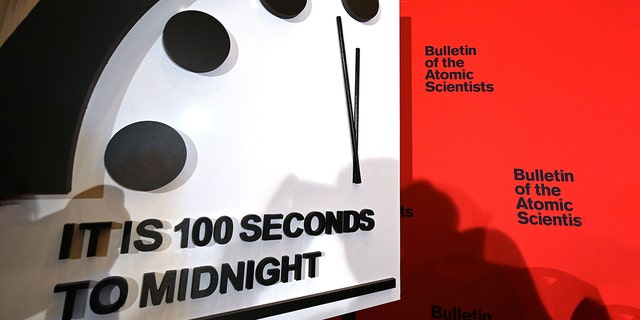The Doomsday Clock: What is it and why it sped up
The Bulletin of the Atomic Scientists has officially sped up the world’s Doomsday Clock, citing world leaders’ failure to deal with threats of nuclear war. Here’s a brief history of what the clock symbolizes and how it started.
This year’s Doomsday Clock — a rhetorical device for sparking conversation about humanity’s proximity to self-destruction — remains set at 100 seconds until midnight, as it has been for the past two years.
“Today, the members of the Science and Security Board find the world to be no safer than it was last year at this time and therefore has decided to set the #DoomsdayClock once again at 100 seconds to midnight,” said Rachel Bronson, president and CEO of the Bulletin of the Atomic Scientists, in a tweet on Thursday.
Scientists involved in developing the first atomic weapons in the Manhattan Project in 1945 — including Albert Einstein and University of Chicago scientists — created the Doomsday Clock in 1947.
The clock is set annually by the Bulletin’s Science and Security Board and its Board of Sponsors. The Bulletin’s 2022 statement by its editor is addressed to “leaders and citizens of the world.”
The statement notes that “last year’s leadership change in the United States provided hope that what seemed like a global race toward catastrophe might be halted — with renewed U.S. engagement — even reversed.”
However, the statement adds, “The change in U.S. leadership alone was not enough to reverse negative international security trends that had been long in developing and continued across the threat horizon in 2021.”
Prominent topics in the memo include nuclear threats, the “January 6 insurrection,” climate change, the COVID-19 pandemic, and “disruptive technology in the age of information.”
The memo also offers suggestions for “practical steps to move the world away from catastrophe.” Then it concludes, “Without swift and focused action, truly catastrophic events — events that could end civilization as we know it — are more likely. When the Clock stands at 100 seconds to midnight, we are all threatened.”
It says as well, “The moment is both perilous and unsustainable, and the time to act is now.”

The Doomsday Clock reads 100 seconds to midnight, a decision made by the Bulletin of the Atomic Scientists (just as it did back in January 2020 and last year as well). The clock was first created in 1947.
(Photo by EVA HAMBACH/AFP via Getty Images)
Here’s a by-the-numbers breakdown of the Doomsday Clock:
75 — the number of years it’s been around. The “clock” has been maintained since 1947 by the members of the Bulletin of the Atomic Scientists.
100 — the number of seconds until midnight the “clock” is set at this year.
24 — the number of times the Bulletin has reset the minute hand on the “clock” since 1947. Before this year, it did so in 2020.
2 — the number of minutes until midnight the “clock” had been set before 2020 — which, up to that year of 2020, had been the closest the “clock” had been set to the stroke of midnight.
11 — the number of Nobel laureates who are involved in the Bulletin’s Science and Security Board and its Board of Sponsors, according to the group’s statement on Thursday.
By the way, the Bulletin of Atomic Scientists insists none of this is political.
The group says on its website, “Ensuring the survival of our societies and the human species is not a political agenda. Cooperating with other countries to achieve control of extremely dangerous technologies should not involve partisan politics. If scientists involved with the Bulletin are critical of current policies on nuclear weapons and climate change, it is because those policies increase the possibility of self-destruction.”
GET THE FOX NEWS APP HERE
Share your thoughts in the comments section below.